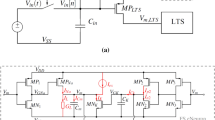Abstract
The silicon neuron is an analog electronic circuit that reproduces the dynamics of a neuron. It is a useful element for artificial neural networks that work in real time. Silicon neuron circuits have to be simple, and at the same time they must be able to realize rich neuronal dynamics in order to reproduce the various activities of neural networks with compact, low-power consumption, and an easy-to-configure circuit. We have been developing a silicon neuron circuit based on the Izhikevich model, which has rich dynamics in spite of its simplicity. In our previous work, we proposed a simple silicon neuron circuit with low power consumption by reconstructing the mathematical structure in the Izhikevich model using an analog electronic circuit. In this article, we propose an improved circuit in which all of the MOSFETs are operated in the sub-threshold region.
Similar content being viewed by others
Explore related subjects
Discover the latest articles, news and stories from top researchers in related subjects.References
Hodgkin AL, Huxley AF (1952) A quantitative description of membrane current and its application to conduction and excitation in nerves. J Physiol 117(4):500–544
Morris C, Lecar H (1981) Voltage oscillations in the barnacle giant muscle fiber. Biophys J 35(1):193–213
Hindmarsh JL, Rose RM (1984) A model of neuronal bursting using three coupled first order differential equations. Proc R Soc B 221(1222):87–102
Hill AAV, Lu J, Masino MA, et al (2001) A model of a segmental oscillator in the leech heartbeat neuronal network. J Comp Neurosci 10:281–302
Izhikevich EM (1999) Weakly pulse-coupled oscillators. FM interactions, synchronization, and oscillatory associative memory. IEEE Trans Neural Networks 10:508–526
Brody CD, Hopfield JJ (2003) Simple networks for spike-timingbased computation, with application to olfactory processing. Neuron 37:843–852
Indiveri G (2003) A low-power adaptive integrate-and-fire neuron circuit. Circuits and systems. ISCAS’3. Proceedings of the 2003 International Symposium, vol 4, pp 820–823
Simoni MF, Cymbalyuk GS, Sorensen ME (2004) A multiconductance silicon neuron with biologically matched dynamics. IEEE Trans Biomed Eng 51(2)
Kohno T, Aihara K (2008) A design method for analog and digital silicon neurons: mathematical-model-based method. AIP Conference Proceedings, vol 1028, pp 113–128
Nagamatsu Y, Aihara K, Kohno T (2010) An Izhikevich-type silicon neuron circuit. Proceedings of the International Symposium on Artificial Life and Robotics 2010, OS4-1, February 6
Izhikevich EM (2003) Simple model of spiking neurons. IEEE Trans Neural Network 14(6)
Izhikevich EM (2004) Which model to use for cortical spiking neurons? IEEE Trans Neural Network 15(5)
Delbruck T (1993) Bump circuits. Technical Report, CNS Memo May 26, Caltech, Pasadena
Kohno T, Aihara K (2008) A simple aVLSI burst silicon neuron circuit. Proceedings of the 2008 International Symposium on Nonlinear Theory and its Applications, pp 556–559
Author information
Authors and Affiliations
Corresponding author
Additional information
This work was presented in part at the 16th International Symposium on Artificial Life and Robotics, Oita, Japan, January 27–29, 2011
About this article
Cite this article
Mizoguchi, N., Nagamatsu, Y., Aihara, K. et al. A two-variable silicon neuron circuit based on the Izhikevich model. Artif Life Robotics 16, 383–388 (2011). https://doi.org/10.1007/s10015-011-0956-2
Received:
Accepted:
Published:
Issue Date:
DOI: https://doi.org/10.1007/s10015-011-0956-2




